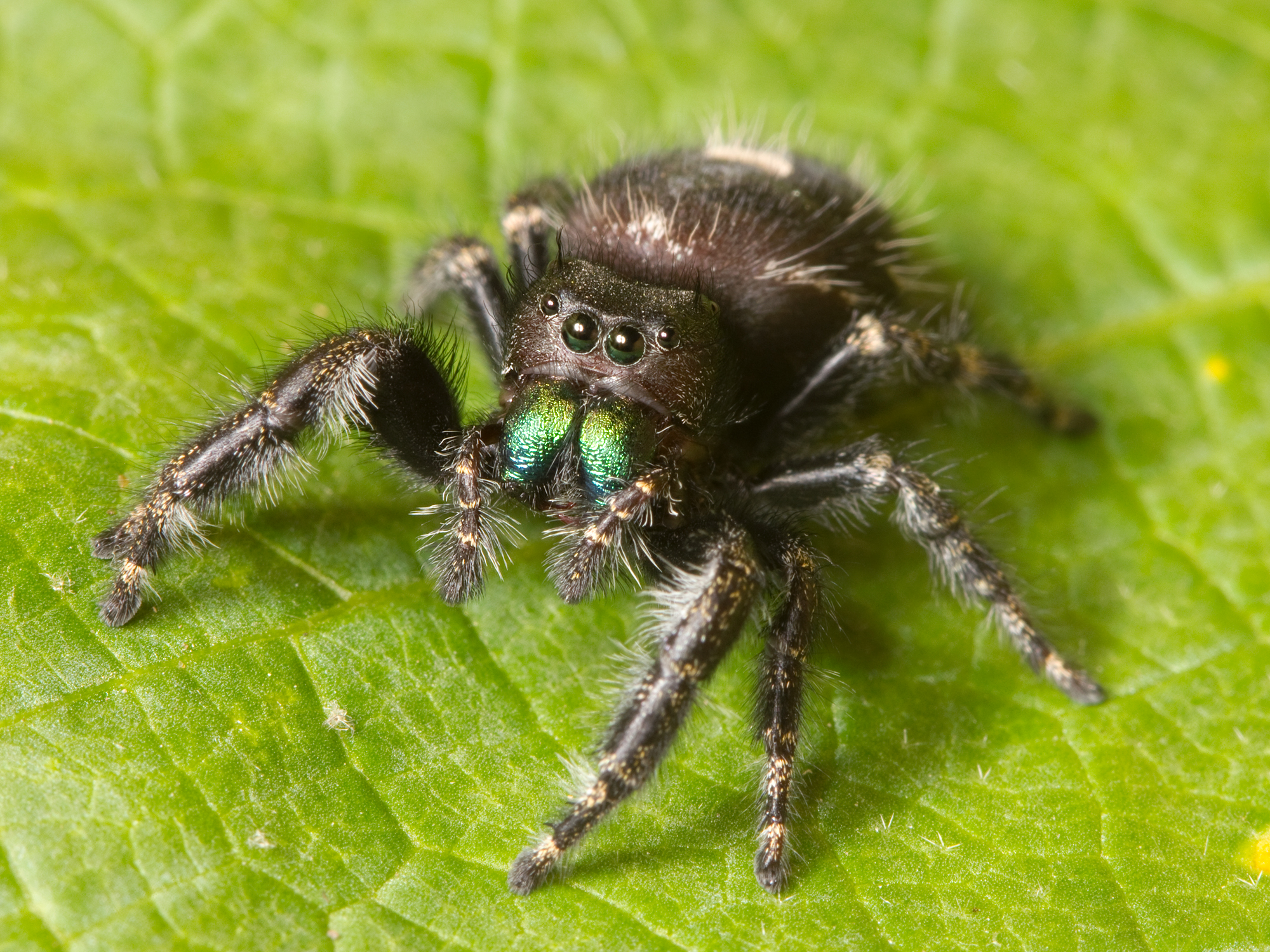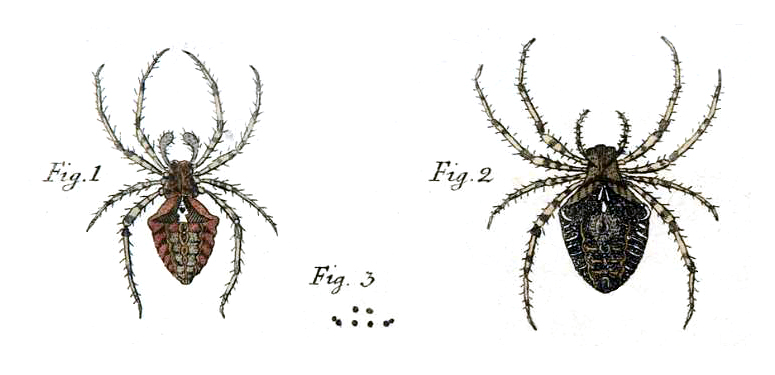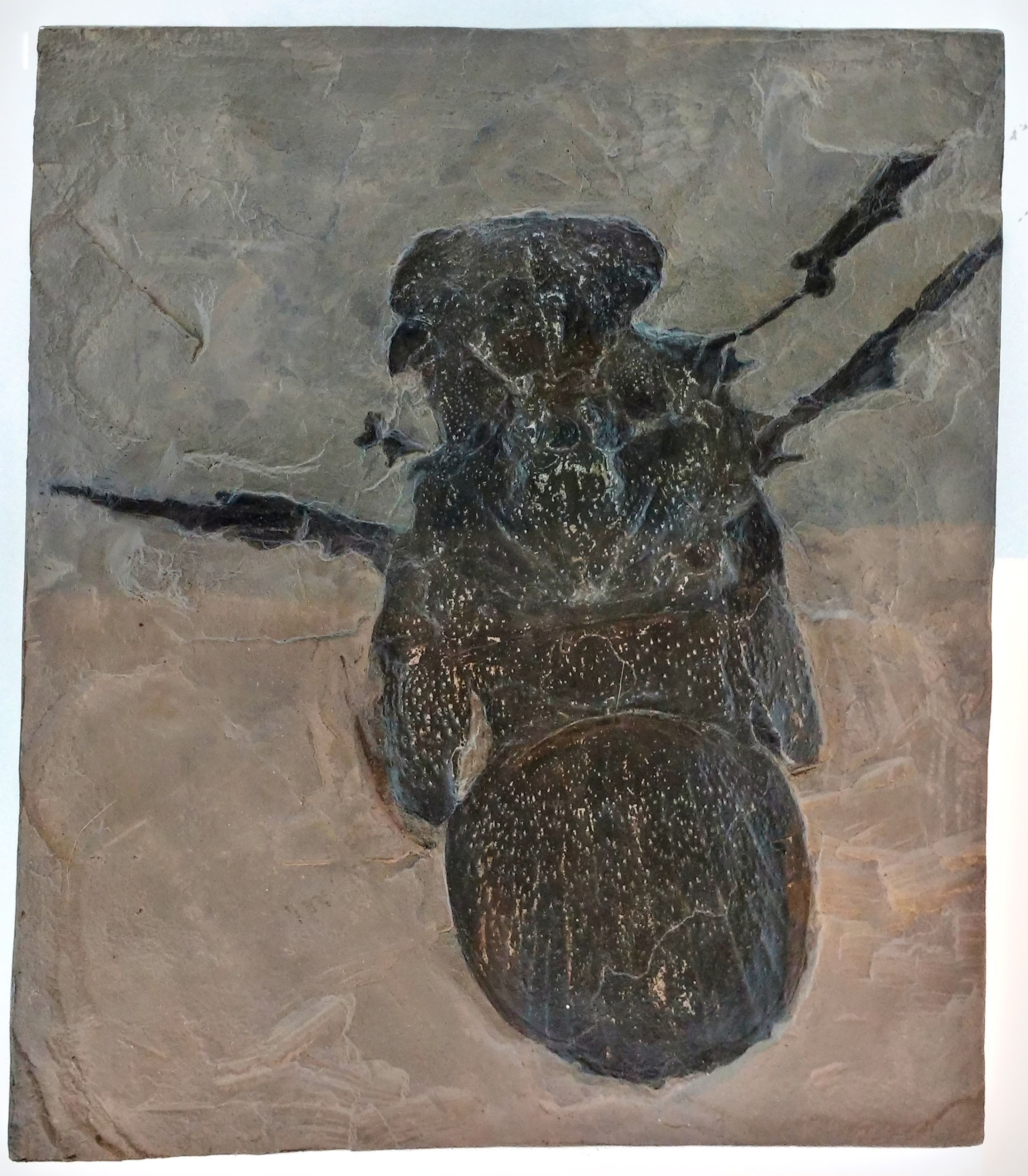|
Spider
Spiders (order Araneae) are air-breathing arthropods that have eight legs, chelicerae with fangs generally able to inject venom, and spinnerets that extrude silk. They are the largest order of arachnids and rank seventh in total species diversity among all orders of organisms. Spiders are found worldwide on every continent except for Antarctica, and have become established in nearly every land habitat. , 50,356 spider species in 132 families have been recorded by taxonomists. However, there has been debate among scientists about how families should be classified, with over 20 different classifications proposed since 1900. Anatomically, spiders (as with all arachnids) differ from other arthropods in that the usual body segments are fused into two tagmata, the cephalothorax or prosoma, and the opisthosoma, or abdomen, and joined by a small, cylindrical pedicel, however, as there is currently neither paleontological nor embryological evidence that spiders ever had a ... [...More Info...] [...Related Items...] OR: [Wikipedia] [Google] [Baidu] |
Salticidae
Jumping spiders are a group of spiders that constitute the family Salticidae. As of 2019, this family contained over 600 described genera and over 6,000 described species, making it the largest family of spiders at 13% of all species. Jumping spiders have some of the best vision among arthropods and use it in courtship, hunting, and navigation. Although they normally move unobtrusively and fairly slowly, most species are capable of very agile jumps, notably when hunting, but sometimes in response to sudden threats or crossing long gaps. Both their book lungs and tracheal system are well-developed, and they use both systems (bimodal breathing). Jumping spiders are generally recognized by their eye pattern. All jumping spiders have four pairs of eyes, with the anterior median pair being particularly large. Distinguishing characteristics Jumping spiders are among the easiest to distinguish from similar spider families because of the shape of the cephalothorax and their eye pa ... [...More Info...] [...Related Items...] OR: [Wikipedia] [Google] [Baidu] |
Cyrtaucheniidae
The wafer trapdoor spiders, family Cyrtaucheniidae, are a widespread family of spiders that lack the thorn-like spines on tarsi and metatarsi I and II (the two outermost leg segments) found in true trapdoor spiders (Ctenizidae). Etymology The scientific family name derives from the Greek κυρταύχην, ''kyrtaúchēn'', which in turn is derived from Greek κυρτός ''kyrtós'', meaning "curved", "arched" or "bent", αὐχήν ''auchen'', meaning the cervix or neck, and the suffix -''idae'', which designates belonging to a family. Biology Many, but not all, make wafer-like doors to their burrows, while others build the cork-like doors found commonly in the true trapdoor spiders. The biology of nearly all the species is poorly known. The monotypic ''Angka hexops'' has only six eyes, with the posterior median eyes missing. It is up to 15 mm long in both sexes.Murphy, Frances & Murphy, John (2000). ''An Introduction to the Spiders of South East Asia''. Kuala Lumpur ... [...More Info...] [...Related Items...] OR: [Wikipedia] [Google] [Baidu] |
Spinnerets
A spinneret is a silk-spinning organ of a spider or the larva of an insect. Some adult insects also have spinnerets, such as those borne on the forelegs of Embioptera. Spinnerets are usually on the underside of a spider's opisthosoma, and are typically segmented. While most spiders have six spinnerets, some have two, four, or eight. They can move both independently and in concert. Most spinnerets are not simple structures with a single orifice producing a single thread, but complex structures of many microscopic spigots, each producing one filament. This produces the necessary orientation of the protein molecules, without which the silk would be weak and useless. Spigots can be singular or found in groups, which also permits spiders to combine multiple filaments in different ways to produce many kinds of silk for various purposes. Spinneret morphology can help arachnologists identify the taxon of a specimen and the specific morphology of a spigot can determine its use as well ... [...More Info...] [...Related Items...] OR: [Wikipedia] [Google] [Baidu] |
Venom
Venom or zootoxin is a type of toxin produced by an animal that is actively delivered through a wound by means of a bite, sting, or similar action. The toxin is delivered through a specially evolved ''venom apparatus'', such as fangs or a stinger, in a process called envenomation. Venom is often distinguished from poison, which is a toxin that is passively delivered by being ingested, inhaled, or absorbed through the skin, and toxungen, which is actively transferred to the external surface of another animal via a physical delivery mechanism. Venom has evolved in terrestrial and marine environments and in a wide variety of animals: both predators and prey, and both vertebrates and invertebrates. Venoms kill through the action of at least four major classes of toxin, namely necrotoxins and cytotoxins, which kill cells; neurotoxins, which affect nervous systems; myotoxins, which damage muscles; and haemotoxins, which disrupt blood clotting. Venomous animals cause tens of thousa ... [...More Info...] [...Related Items...] OR: [Wikipedia] [Google] [Baidu] |
Chelicerae
The chelicerae () are the mouthparts of the subphylum Chelicerata, an arthropod group that includes arachnids, horseshoe crabs, and sea spiders. Commonly referred to as "jaws", chelicerae may be shaped as either articulated fangs, or similarly to pincers. Some chelicerae, such as those found on nearly all spiders, are hollow and contain (or are connected to) venom glands, and are used to inject venom into prey or a perceived threat. In ''Pisaurina mira'', also known as the nursery web spider, the chelicerae are utilized to snatch the prey once it becomes within reach, facilitating the "sit-and-wait ambush predator" behavior. Both pseudoscorpions and harvestmen have structures on their chelicerae that are used for grooming (papillae in pseudoscorpions, cheliceral teeth in Opiliones). Types Chelicerae can be divided into three kinds: jackknife chelicerae, scissor chelicerae, and 3-segmented chelate chelicerae. Jackknife chelicerae The jackknife chelicera is subchelate (with ... [...More Info...] [...Related Items...] OR: [Wikipedia] [Google] [Baidu] |
Arthropod
Arthropods (, (gen. ποδός)) are invertebrate animals with an exoskeleton, a Segmentation (biology), segmented body, and paired jointed appendages. Arthropods form the phylum Arthropoda. They are distinguished by their jointed limbs and Arthropod cuticle, cuticle made of chitin, often Mineralization (biology), mineralised with calcium carbonate. The arthropod body plan consists of segments, each with a pair of appendages. Arthropods are bilaterally symmetrical and their body possesses an exoskeleton, external skeleton. In order to keep growing, they must go through stages of moulting, a process by which they shed their exoskeleton to reveal a new one. Some species have wings. They are an extremely diverse group, with up to 10 million species. The haemocoel, an arthropod's internal cavity, through which its haemolymph – analogue of blood – circulates, accommodates its interior Organ (anatomy), organs; it has an open circulatory system. Like their exteriors, the internal or ... [...More Info...] [...Related Items...] OR: [Wikipedia] [Google] [Baidu] |
Order (biology)
Order ( la, wikt:ordo#Latin, ordo) is one of the eight major hierarchical taxonomic ranks in Linnaean taxonomy. It is classified between Family_(biology), family and Class_(biology), class. In biological classification, the order is a taxonomic rank used in the classification of organisms and recognized by the nomenclature codes. An immediately higher rank, superorder, is sometimes added directly above order, with suborder directly beneath order. An order can also be defined as a group of related families. What does and does not belong to each order is determined by a taxonomist, as is whether a particular order should be recognized at all. Often there is no exact agreement, with different taxonomists each taking a different position. There are no hard rules that a taxonomist needs to follow in describing or recognizing an order. Some taxa are accepted almost universally, while others are recognized only rarely. The name of an order is usually written with a capital letter. Fo ... [...More Info...] [...Related Items...] OR: [Wikipedia] [Google] [Baidu] |
Spider Taxonomy
Spider taxonomy is that part of taxonomy that is concerned with the science of naming, defining and classifying all spiders, members of the Araneae order of the arthropod class Arachnida with more than 48,500 described species. However, there are likely many species that have escaped the human eye to this day, and many specimens stored in collections waiting to be described and classified. It is estimated that only one third to one half of the total number of existing species have been described. Arachnologists currently divide spiders into two suborders with about 129 families. Due to constant research, with new species being discovered every month and others being recognized as synonyms, the number of species in the families is bound to change and only reflects the present state of knowledge. Nevertheless, the species numbers given here are useful as a guideline – see the table of families at the end of the article. History Spider taxonomy can be traced to the work of S ... [...More Info...] [...Related Items...] OR: [Wikipedia] [Google] [Baidu] |
Araneomorphae
The Araneomorphae (also called the Labidognatha) are an infraorder of spiders. They are distinguishable by chelicerae (fangs) that point diagonally forward and cross in a pinching action, in contrast to the Mygalomorphae (tarantulas and their close kin), where they point straight down. Araneomorphs comprise the vast majority of living spiders. Distinguishing characteristics Most spider species are Araneomorphae, which have fangs that face towards each other, increasing the orientations they can employ during prey capture. They have fewer book lungs (when present), and the females typically live one year. The Mygalomorphae have fangs that face towards the ground, and which are parallel to the long axis of the spider's body, thus they have only one orientation they can employ during prey capture. They have four pairs of book lungs, and the females often live many years. Image:Atrax robustus.jpg, This ''Atrax robustus'' shows the orientation of Myglamorphae fangs. Image:Che ... [...More Info...] [...Related Items...] OR: [Wikipedia] [Google] [Baidu] |
Mygalomorphae
The Mygalomorphae, or mygalomorphs, are an infraorder of spiders, and comprise one of three major groups of living spiders with over 3000 species, found on all continents except Antarctica. Many members are known as trapdoor spiders due to them forming trapdoors over their burrows. Other prominent groups include Australian funnel web spiders and tarantulas, with the latter accounting for around one third of all mygalomorphs. Description This group of spiders comprises mostly heavy-bodied, stout-legged spiders including tarantulas, Australian funnel-web spiders, mouse spiders, and various families of spiders commonly called trapdoor spiders. Like the " primitive" suborder of spiders Mesothelae, they have two pairs of book lungs, and downward-pointing chelicerae. Because of this, the two groups were once believed to be closely related. Later it was realized that the common ancestors of all spiders had these features (a state known as symplesiomorphy). Following the branching ... [...More Info...] [...Related Items...] OR: [Wikipedia] [Google] [Baidu] |
Opisthothelae
The Opisthothelae are spiders within the order Araneae, consisting of the Mygalomorphae and the Araneomorphae, but excluding the Mesothelae. The Opisthothelae are sometimes presented as an unranked clade and sometimes as a suborder of the Araneae. In the latter case, the Mygalomorphae and Araneomorphae are treated as infraorders. The fairly recent creation of this taxon has been justified by the requirement to distinguish these spiders from the Mesothelae, which display many more primitive characteristics. Those that distinguish between the Mesothelae and Opisthothelae are: * The tergite plates on the abdomen of Mesothelae but absent in Opisthothelae * The almost total absence of ganglia in the abdomen of Opisthothelae * The almost median position of the spinnerets in the Mesothelae compared with the hindmost position of those of the Opistothelae Among the Opisthothelae, the fangs of the Mygalomorphae point straight down in front of the mouth aperture and only allow the sp ... [...More Info...] [...Related Items...] OR: [Wikipedia] [Google] [Baidu] |
Mesothelae
The Mesothelae are a suborder of spiders (order Araneae) that includes a single extant family, Liphistiidae, and a number of extinct families. This suborder is thought to form the sister group to all other living spiders, and to retain ancestral characters, such as a segmented abdomen with spinnerets in the middle and two pairs of book lungs. Members of Liphistiidae are medium to large spiders with eight eyes grouped on a tubercle. They are found only in China, Japan, and southeast Asia. The oldest known Mesothelae spiders are known from the Carboniferous, over 300 million years ago. The Heptathelidae were once considered their own family; today they are considered a subfamily of the Liphistiidae. Description Members of Mesothelae have paraxial chelicerae, two pairs of coxal glands on the legs, eight eyes grouped on a nodule, two pairs of book lungs, and no endites on the base of the pedipalp. Most have at least seven or eight spinnerets near the middle of the abdomen. Lateral ... [...More Info...] [...Related Items...] OR: [Wikipedia] [Google] [Baidu] |







